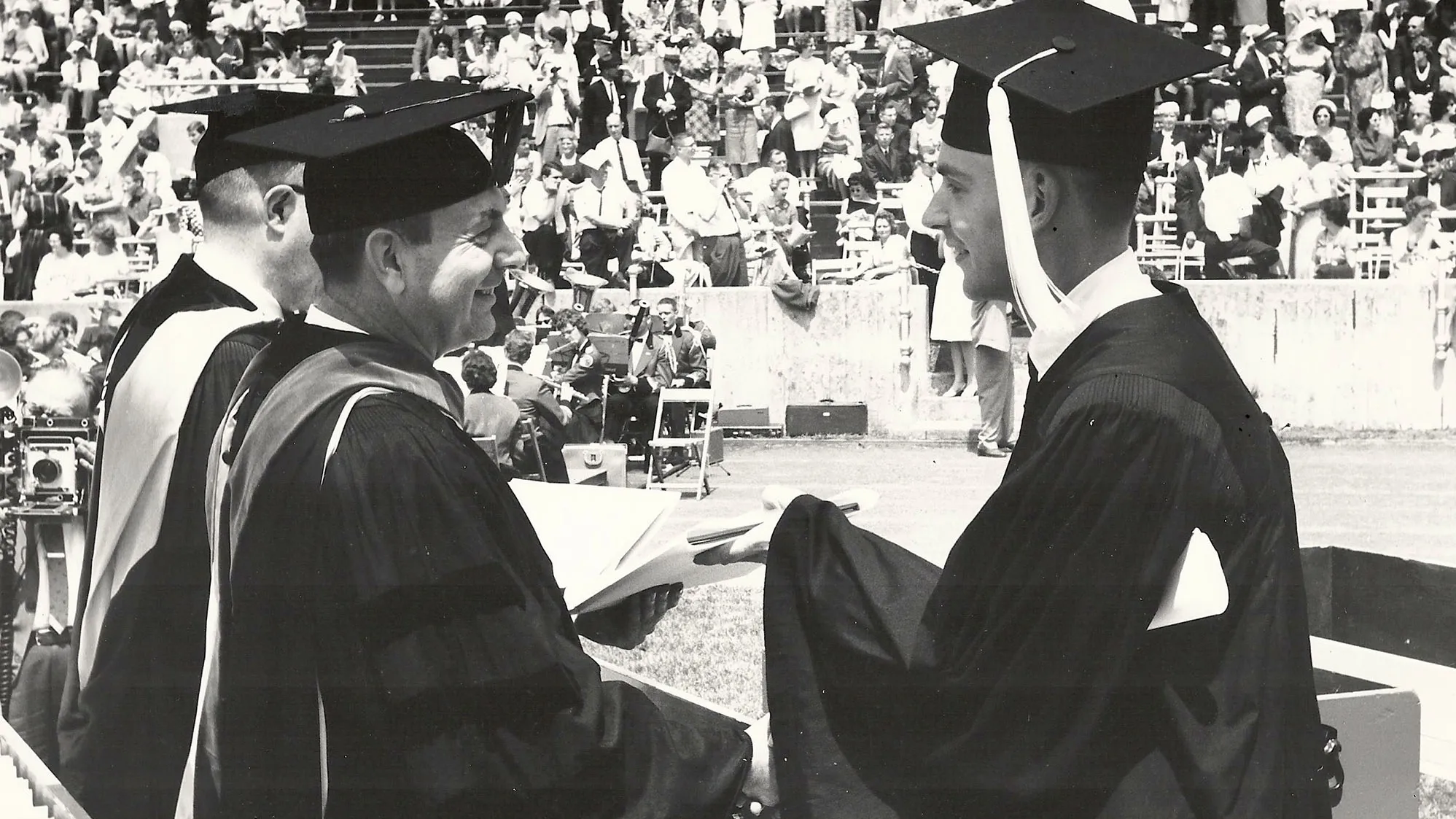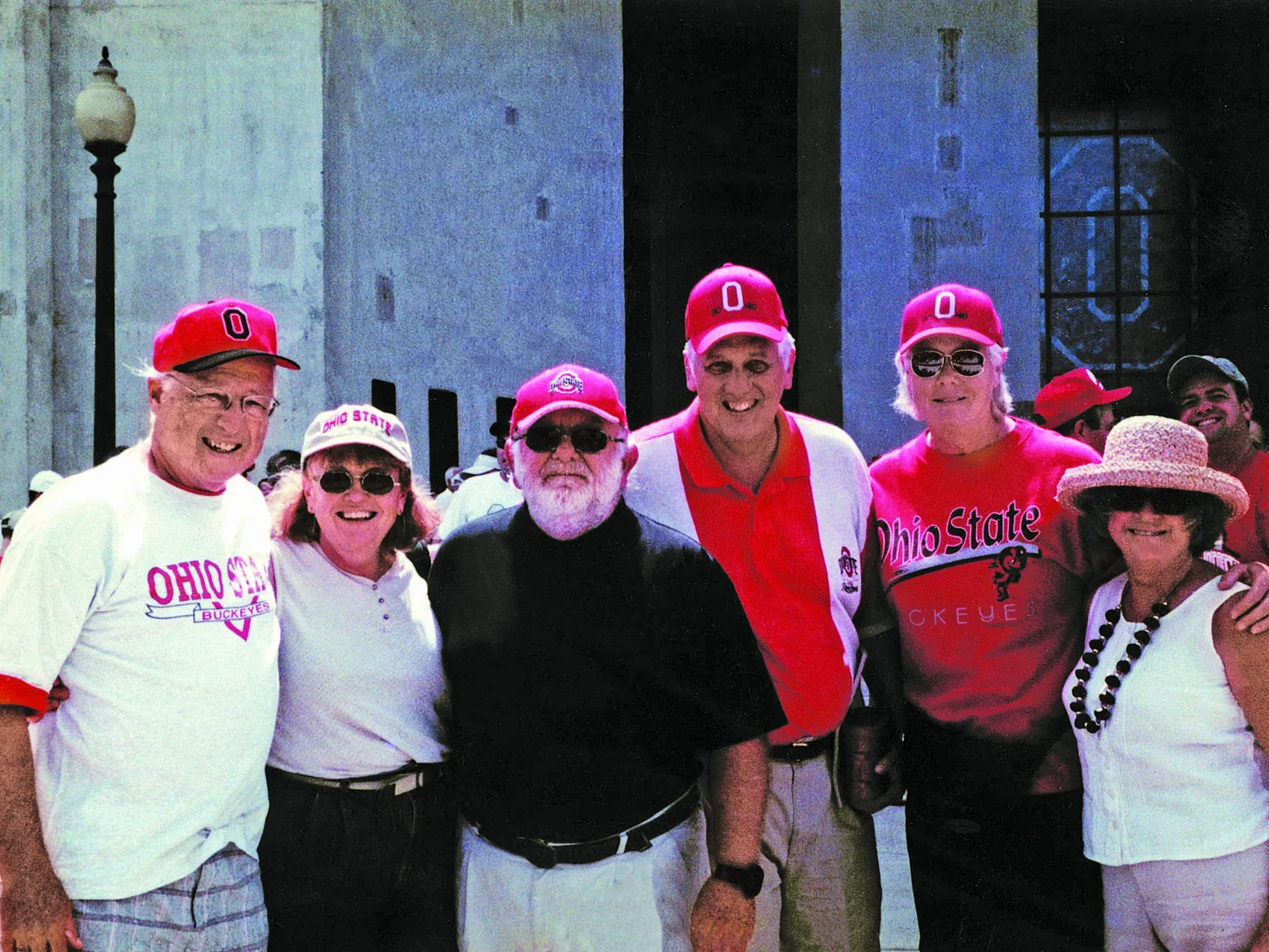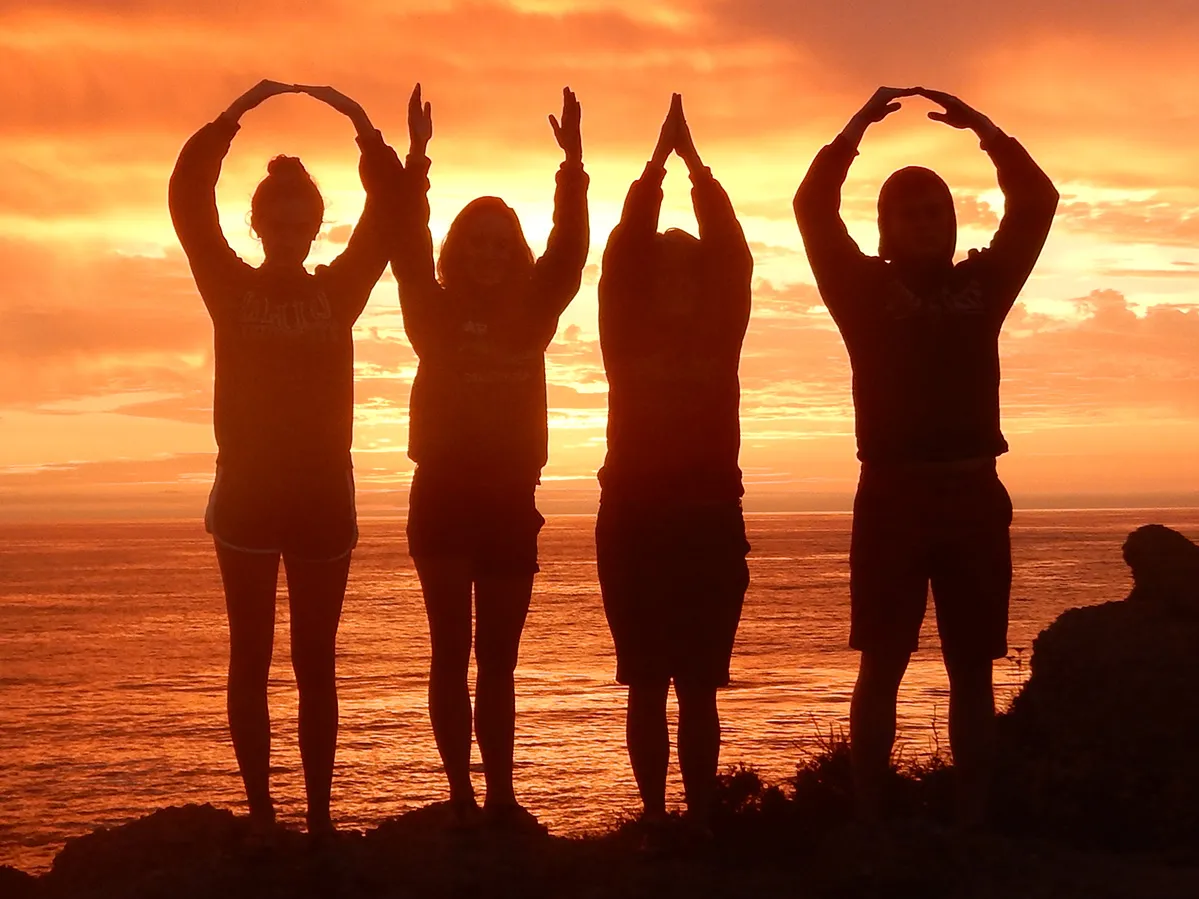A single class sparked this journalist’s calling
For Ronald G. Shafer ’62, a story assignment about a bubblegummed Little Leaguer kicked off his storied career covering notable people and politics.

Ronald G. Shafer happily accepts his diploma in 1962 from J. Osborn Fuller, then dean of the College of Arts and Sciences. (Photo courtesy of Shafer)
To borrow from “Carmen Ohio,” time and change have surely shown me one thing: A single class can launch an entire career. For me, the class was magazine writing, which led to my 38 years at The Wall Street Journal and my writing to this day for The Washington Post.
In spring 1961, Professor Paul Barton assigned an article based on a personal experience. I wrote about being a Little League baseball manager in Columbus, my hometown. My first draft was a mishmash. Professor Barton suggested I focus on my humorous anecdotes, such as a pint-sized player who slid into second base blowing a bubble. The bubble burst, entangling his hair in gum.
Figuring I had nothing to lose, I mailed the final version to Sports Illustrated. To my surprise, I received a letter from an editor who wrote, “I don’t believe a word of your story, but we’d like to publish it in Sports Illustrated.” SI paid me $200, the equivalent of about $2,000 today.
In February 1962, John McWethy, Chicago bureau chief of The Wall Street Journal, came to campus on a recruiting trip. Looking over my material, he said, “Well, Ron, if Sports Illustrated liked your writing enough to pay for it, I figure you should come work for us.” I was thought to be the first Ohio State journalism student the paper hired.
My college era of the late 1950s and early 1960s was a prime time to study journalism at Ohio State and a golden era for Buckeye sports. In 1960, the basketball team led by Jerry Lucas and John Havlicek won the national title. Undergraduate Jack Nicklaus, still an amateur golfer, finished second in the U.S. Open that year. In 1961, the football team, coached by Woody Hayes, went undefeated and earned an invitation to the Rose Bowl.
As a Lantern reporter, I wrote about student protests that ensued when the Faculty Council voted to decline the Rose Bowl bid, thinking it would emphasize Ohio State as a “football school” over academics. But the decision stood.
Meanwhile, the ripple effect from my magazine class story continued when I was named Lantern editor-in-chief. My editorial editor was Len Downie ’64, who later became executive editor of The Washington Post. There, his Ivy League colleagues nicknamed him “Land Grant Len.” Over at The Sundial humor magazine, the staff included “Jovial Bob” Stine ’65, known today as R.L. Stine, author of the “Goosebumps” books.

This article in The Lantern announced the appointment of the student newspaper’s top editors for the spring term in 1962. (Clipping from University Archives)
As Lantern editor, I routinely parked my car outside the Journalism Building and often returned about midnight to find that campus cops had dutifully placed parking tickets behind my wipers. I dutifully neglected to pay them because I was broke. (Working to be the first in my family to graduate from college, I was paying my own way.) The tickets weren’t a problem until my first day at the WSJ’s Chicago bureau in January 1963. My new employer wanted my transcript, and Ohio State wouldn’t release it until I paid my parking tickets.
By 1973, I was in Washington during the emerging Watergate scandal. Every day I phoned the agency I covered, the Department of Housing and Urban Development, to dig for leads. One day I was told Housing Secretary James Lynn, a Nixon cabinet member, wanted to talk to me, apparently to do a little digging of his own. He got on the phone and said, “Ron, Ron. Have you heard anything?” I responded: “No, no, Lynn. That’s what I’m supposed to ask you.”
My years at The Wall Street Journal were memorable, giving me the opportunity to turn out page-one features about such people as Ralph Nader, humor columnist Art Buchwald and Lee Elder before he became the first Black golfer to compete in the Masters Tournament.
After interviewing Elder at the Doral Open in Florida in 1974, I was returning to my hotel room when an elevator door opened and out walked fellow Buckeye Jack Nicklaus. I began babbling about how we both went to Ohio State and the story I was writing about Elder. The great golfer looked dazed but gave me a quote.
I rushed to our room to tell my wife, Barbara, but first she had something to tell me. That afternoon she got into an elevator, and there was Nicklaus. She said she babbled about how her husband went to Ohio State with him and was there writing a story. (Jack probably took the stairs for the rest of the tournament.)
Never in my worst nightmares did I dream I’d write one story published in 1989. It was about the death of my 16-year-old son, Ryan, after he used LSD and ran into traffic. The story drew huge media attention, and President George H.W. Bush mentioned it in a speech. The Journal nominated it for a Pulitzer Prize.
The dark clouds continued for me and my daughter, Kathryn, when we lost Barbara to breast cancer in 1993. Five years later, I married entrepreneur Mary Rogers, who brought love and adventure to my life. On an excursion with her to the Great Wall of China, I was wearing my red Block O baseball cap when someone called out “O-H,” reminding me of the breadth of our Buckeye Nation.
By then I was Washington political features editor for the Journal and wrote the page-one column Washington Wire. The paper’s news side is independent of the editorials, and I followed my lesson from Ohio State to “walk down the middle of the street with a slingshot and shoot out windows on both sides.” I don’t envy the journalists assigned to write about politics these days.
Having attended the nominating conventions for presidents from Jimmy Carter to George W. Bush, I retired in 2001. Today, I live in Williamsburg, Virginia, and write freelance articles for the Retropolis column of The Washington Post. I recently published a collection of my articles, including one about the Smithsonian Institution statue of President Washington portrayed as a bare-chested Greek god, in the book A Half-Naked George Washington And Other True Tales From History.
It would be great to hear what campus experiences other alums have carried forward. For me, two things haven’t changed: I always root for Ohio State sports teams and I give thanks for that magazine writing class 63 years ago.


